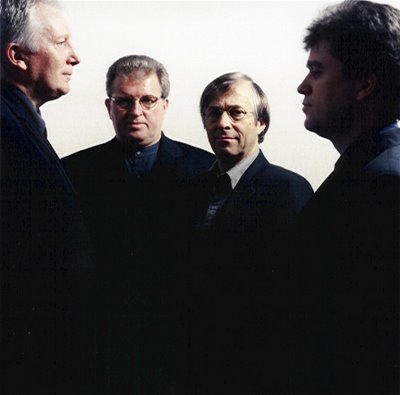
Hilliard Ensemble (L to R, Gordon Jones, David James, Rogers Covey-Crump, Steven Harrold), photo by Friedrun Reinhold |
Whenever the Hilliard Ensemble comes to town, you can be sure to find Ionarts ready to listen. The esteemed British vocal quartet, founded by Paul Hillier and others in the 1970s, produced now classic recordings in the late 20th century that changed forever the experience of listening to Renaissance polyphony (continuing with more recent releases like a very worthy Gombert disc three years ago). At the Kennedy Center Terrace Theater on Thursday night, as in their 2007 concert at the Freer Gallery of Art, it quickly became clear that the group has lost some of the steely polish of their legendary sound, but one is still guaranteed to hear sensitive, transporting performances of the monuments of unaccompanied vocal polyphony, presented as this music was likely intended, at or near the original key levels and sung by a small number of all male voices.
This program was anchored on the four-part setting of the Ordinary and most of the Propers of the Mass for the Dead by Orlando Lassus (1532-1594). A simple and somber setting, it consists largely of homophonic chords that bloom and close back up gently and slowly. It strikes the ear as fairly utilitarian, requiring only about thirty minutes to perform -- the Hosanna refrain of the Sanctus, for example, is only a few bars of rather plain chords. It did not seem to inspire the singers to great expressive heights, mostly revealing some of the voices' weakness, either from the strain of touring or illness. It was a far cry from the group's classic recording from the 1990s (now reissued by ECM), where the Requiem was paired with the composer's daringly chromatic prophecies of the sibyls.
Both tenors, Rogers Covey-Crump and Steven Harrold, sounded a bit scratchy and unclear, and the ensemble intonation went awry at times, particularly in the Gradual. Whenever Lassus reduced the texture from four parts, as in the tenor-bass duet in the Gradual's verse, these weaknesses were spotlighted. The group's signature attention to the proper declamation of text was still remarkable, with each line rising in turn to the fore in contrapuntal passages and then receding to allow the following one to surge over it, and unaccented final syllables at major cadence points melted into perfectly tuned, relaxed, and sweet chords.
To make a program that lasted just over an hour with no intermission, the Lassus was augmented with a few of Palestrina's settings of responsory texts from the Office of the Dead (also recorded by the group in the 1990s and reissued by ECM). Strangely, the comparison showed Palestrina, a composer who is often held up as a model of balance and restraint, as the more daring and emotional. Where Lassus had eschewed any kind of text painting, not using a starkly descending bass line to describe the "profundo lacu" of the Offertory, for example, Palestrina provided many such expressive musical images, such as the upward-arcing arrows of the vocal lines at the word "Sagittae" in Ad dominum cum tribularer. Even Palestrina's harmonic vocabulary was more extensive and unusual, especially the unexpected progressions in the exquisite closing Kyrie section of Libera me domine.
One of the most pleasing things about this concert was the performance of the Gregorian chant pieces, included to complete the required texts not set as polyphony. The Hilliard Ensemble hit exactly the right contrast between the measured, gently propulsive sound of metered polyphony and the serene quasi-timelessness of unmetered chant. The effect was most obvious in Palestrina's alternatim setting of the great penitential psalm Miserere mei, a foretaste on this concert of the Lenten season soon to come. More and more of the Hilliard Ensemble's work these days, however, is devoted to modern music, and indeed the encore, a miniature by Piers Hellawell called Sapphire, sparkled with energy that had seemed largely dormant throughout the rest of the concert.
The next major event at the Kennedy Center Terrace Theater is tomorrow afternoon's Beethoven marathon by cellist David Hardy and pianist Lambert Orkis (February 15, 2 pm and 4:30 pm).






















































No comments:
Post a Comment